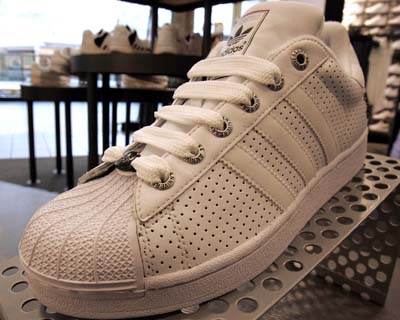
Daniel Mears / The Detroit News
Adidas has introduced 35th anniversary editions of the Superstar, aka the shell toe.
Think you know Adidas shell toes? Read on. And if this timeline isn't enough for you sneakerheads, go to the source -- Adidas provides a full history on its Web site ( http://www.adidas.com/).
1970: The Superstar or shell toe gets its start in the United States (it is available in Europe a year prior, when Adidas founder Adi Dassler and his team of designers created the shoe). In the United States, the basketball shoe debuts on courts at ABA (the now defunct American Basketball Association) and NCAA games. Soon basketball players, professional and amateur, start wearing the shoe. Players like the leather -- most sneakers at the time are canvas -- and the unique "shell toe" design. The shoe is sold primarily in sports equipment stores; its limited availability only adds to its status.
1973-75: Basketball great Kareem Abdul-Jabbar proves that it's not always the shoe, but who is wearing the shoe that matters. When Abdul-Jabbar sports the Adidas half shell -- a model with half a shell on the toe and suede on the toe box -- children of all colors, especially those in America's inner cities, fall in love with Adidas.
1978: As Abdul-Jabbar's popularity grows (he's with the Los Angeles Lakers for three years by 1978) so does corporate interest. Adidas creates the Jabbar sneaker in honor of the 7-foot-2 star.
1980: The shoe starts its transition from ball players to breakdancers and rappers, who embrace the shell-toed Superstar. The brand adds a little flair to the Superstar by applying the Trefoil, or the Adidas symbol, to the back of the shoe or outsole. Breakdancers could not care less. They like the shoe's tough leather toe for certain moves and rappers, DJs and young hip-hop fans like the shoe's edgy design. B-Boys, the first recognizable breakdancers, customize the shoes by painting the stripes on the side in outrageous, hard-to-find colors and fat laces become a staple.
1985: Run-DMC releases the LP single "My Adidas" as a precursor to their album "Raising Hell," which is released the following year. The Hollis, Queens, N.Y., trio raps about the shoe because they like them and are not initially paid to do so. They also customize the shoe by wearing them without laces. About a year after the song is released, Run-DMC tell an audience to hold their Adidas in the air. When the sky is filled with shell toes, Adidas executives take notice.
1988: The Ultrastar, a shoe designed exclusively for Run-DMC, is born and Run-DMC are spokesmen. The Ultrastar is a lot like the Superstar, except it has a thicker tongue, allowing the shoe to be worn without laces.
1990: Hip-hop interest in the Superstar wanes, but thanks to the crossover appeal of the Run-DMC song "Walk This Way," suburban kids and even rock stars adapt the shell toe. But the shoes become harder to find. The Superstar 2 is also born and has a thicker tongue for added comfort. Unusual decals and other doodles are added to the stripes on the side to appeal to women and girls.
1991: Adidas reissues the Superstar. A year later, Adidas enjoys a third wave of popularity as skateboarders and skater-punk wannabes embrace the shoe.
1995: A decade after rappers Run-DMC talk about their Adidas, rockers bring the shoe to the counterculture in the United States, Europe and in Japan. Trip hoppers, such as Fred Durst of Limp Bizkit, lead the unofficial campaign inspiring frat boys to wear the shoe. The Superstar also becomes a staple in sneakerheads' collections all over the world.
2000: In an attempt to appeal to more consumers, Adidas releases the Superstar Lux, a brown-colored hybrid that resembles Rockports.
2005: Adidas celebrates its 35th anniversary in the United States and creates several new series to commemorate the milestone. Among them are the cities series, which celebrates cities such as London, Paris, New York and Boston, with decals on the shoes that are synonymous with the metropolises. There's also the Music series, which features Superstars with custom designs from rapper and producer Missy Elliott; Ian Brown, lead singer of the band Stone Roses; and a shoelace-free pair designed by the remaining members of Run-DMC. All proceeds from the sale of the shoe go to the Jam Master Jay Foundation in honor of the slain DJ, who died Oct. 30, 2002.
No comments:
Post a Comment